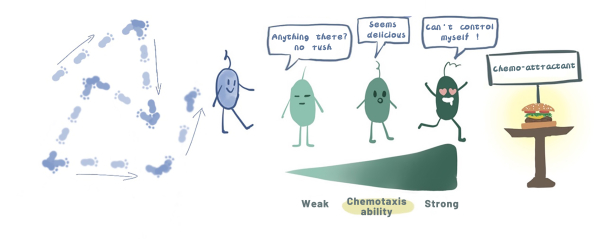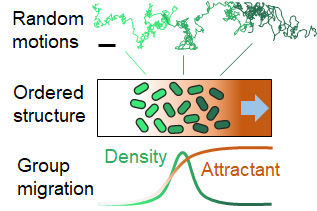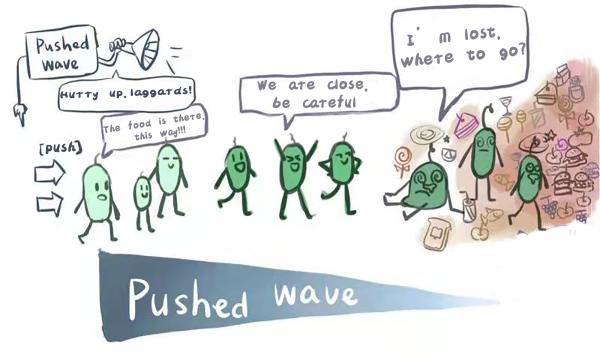Research Discovers General Principle Organizes Phenotypically Diverse Bacteria during Collective Migration
Date:08-11-2021 | 【Print】 【close】
Organisms living in large groups often have to move together in order to navigate, forage for food, and increase their roaming range. Such groups are often made up of distinct individuals that must integrate their different behaviors in order to migrate in the same direction at a similar pace. For instance, for the bacteria Escherichia coli to travel as a condensed group, they must coordinate their response to a set of chemical signals called chemoattractants that tell them where to go.
The chemoattractants surrounding the bacteria are unequally distributed so that there is more of them at the front than the back of the group. During migration, each bacterium moves towards this concentration gradient in a distinct way, spontaneously rotating its direction in a ‘run-and-tumble’ motion that guides it towards areas where there are high levels of these chemical signals.

Schematic diagram of random walk and chemotactic ability difference of bacteria (Image by CAI Zhuoran, WU Wei)
In addition to this variability, how well individual bacteria are able to swim up the gradient also differs within the population. Bacteria that are better at sensing the chemoattractant gradient are placed at the front of the group, while those that are worst are shifted towards the back. This spatial arrangement is thought to help the bacteria migrate together. But how E. coli organize themselves in to this pattern is unclear, especially as they cannot communicate directly with one another and display such diverse, randomized behaviors.

Bacterial population of diverse phenotypes sorted according to their chemotactic abilities (Image by CAI Zhuoran, WU Wei)
To help answer this question, Dr. FU Xiongfei and his team from the Shenzhen Institute of Advanced Technology (SIAT) of the Chinese Academy of Sciences have discovered a general principle that a self-generated "pushed driving force" enables bacteria to modulate their behaviors according to their migration ability to arrange themselves.
These researchers have investigated trajectories of individual E. coli in the group migration. The results showed that E. coli alter their run-and-tumble motion depending on where they reside within the population: individuals at the rear drift faster so they can catch up with the group, while those leading the group drift slower to draw themselves back. This "reversion behavior" reflects a "pushed driving force" where a cell is more "pushed" on the back than in the front. It allows the migrating bacteria to travel at a constant speed around a mean position relative to the group.
A cell’s drifting speed is determined by how well it moves towards the chemoattractant and its response to the concentration gradient. As a result, the mean position around which the bacterium accelerates or deaccelerates will vary depending on how sensitive it is to the chemoattractant gradient. The E. coli therefore spatially arrange themselves so that the more sensitive bacteria are located at the front of the group where the gradient is shallower; and cells that are less sensitive are located towards the back where the gradient is steeper.

"reversion behavior" reflects a "pushed driving force" (Image by CAI Zhuoran, WU Wei)

Bacteria forming an ordered queue (Image by CAI Zhuoran, WU Wei)
"These findings suggest a general principle for how bacteria form ordered patterns whilst migrating as a collective group. This behavior could also apply to other populations of distinct individuals, such as ants following a trail or flocks of birds migrating in between seasons." said Dr. FU.
This study entitled "Spatial modulation of individual behaviors enables an ordered structure of diverse phenotypes during bacterial group migration" has been published eLife on November 2, 2021.
Media Contact:
ZHANG Xiaomin
Email:xm.zhang@siat.ac.cn